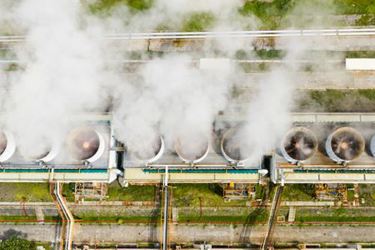Geothermal Energy Market: Monetizing The Hidden Benefits Of Power Beneath Earth
By Sham Ambhore

In the quest to sequester carbon emissions, harnessing energy from geothermal sources is proving to be an efficient tool. When we burn coal, it generates an average of 800 grams of carbon dioxide equivalent per kilowatt-hour of electricity generated, or gCO2eq/kWh, while geothermal energy has a carbon intensity of almost 35 gCO2eq/kWh. Hence, we can say that geothermal is a cleaner and far greener source of energy. Let us see the evolution of geothermal energy during the recent years:
|
Year |
Development |
|
11,000 years ago |
Paleo-Indian Americans utilized water from hot springs for bathing, cooking, and cleaning |
|
1827 |
The first industrial use of geothermal energy began in Pisa |
|
1922 |
The first geothermal plant in the U.S. started with a capacity of 250 kilowatts |
|
1946 |
The very first geothermal heat pump was installed at the Commonwealth Building |
|
1960 |
A company began operation on a large scale in San Francisco producing 11 megawatts |
|
1997 |
Governments of various countries joined hands to fight against climate change |
|
2019 |
More than 60 geothermal power plants are operating in the U.S. in 18 sites |
Current output for countries leading in geothermal energy production:
|
Country |
Watts/person % |
TWh |
|
Iceland |
1772.3 W |
29.0% 5.7 TWh |
|
New Zealand |
167.5 W |
17.5% 7 TWh |
|
Costa Rica |
32 W |
12% 1.5 TWh |
|
El Salvador |
28 W |
19.3% 1.6 TWh |
Geothermal power is considered the third or fourth prominent source of renewable energy. The technology for harnessing energy from geothermal sources is relatively simple. The widespread popularity of geothermal production can be seen in the form of rising drilling activity in the world. Between the years 2015 and 2020, approximately 180 wells were drilled each year. The number is expected to rise to almost 500 wells by the year 2025. Geothermal energy generated in the year 2020 was almost 14,000 megawatts (MW) of electric power.
Other than this, a geothermal plant of almost 10 MW is capable of generating yearly energy to power more than 23,500 houses. Also, the utilization would eliminate almost 56,000 tons of carbon dioxide each year.
It has been estimated that almost 42 MW of power radiates from the 5100°C temperature of the earth’s core. Also, this would not run out or ever be short of supply for billions of years.
Applications Of Geothermal Energy
Geothermal energy in agriculture: In various cold countries, the geothermal source of energy is widely utilized to heat up irrigation water. Farmers utilize geothermal water in the pipes to adjust the level of humidity according to their requirements. Geothermal energy holds the capability to reshape the agriculture domain. For instance, in Ajnu district in China, geothermal energy is harnessed by farmers for agriculture. Other than this, in Iceland, geothermal energy is used for warming houses, and offices and to grow vegetables including cucumbers in Varma land.
Geothermal energy in industries: Some of the industrial applications of geothermal energy include gold mining, food dehydration, and milk pasteurization. Pasteurization requires almost 610 megajoules (MJ) of thermal and 200 MJ of electric energy. Researchers are trying to harness this much energy from establishing geothermal plants to make the process sustainable.
Geothermal energy in heating systems: Geothermal energy is utilized to heat various buildings with the use of district heating systems. The hot water through springs is taken to the buildings through the pipelines. For instance, the University of Utah is responsible for operating almost 310 buildings that support healthcare, education, housing, and research.
Geothermal Energy Market Analysis
The geothermal energy market is projected to garner US$152 billion by the year 2036, growing at a CAGR of almost 13% between 2024 to 2036. In the year 2023, the market reached US$35 billion in total. The growth of the market can be ascribed to the below written factors:
- Surge in demand for energy
- Supportive government policies
- Rise in research and development in the domain
- Advances in drilling and power plant technologies
- Rise in clean electricity generation
- Shift towards renewables to raise demand
- Rising heating requirements across commercial and residential sectors
However, factors such as limited research and development, limited availability, and exorbitant initial investment are acting as hindrance in the growth of the market.
Furthermore, the North America region has been the fastest-growing region for geothermal energy consumption in the year 2023. The growth of the market in the region can be attributed to dominating residential and commercial applications in the region. It has been estimated that a total of almost 1,750 geothermal wells are present in the U.S.
Other than this, the Asia Pacific region is the second largest region offering lucrative opportunities in the market. The growth of the market can be attributed to rising demand for clean and renewable energy.
Some of the prominent companies in the domain are Reykjavik Geothermal, Ormat Technolgies Inc., Calpine, Enel Green Power North Ameirca Inc, EthosEnergy, GEG Power, First Gen Corporation, ElectraTherm, Berkshire Hathaway Energy, Turboden S.p.A.
Wrapping Up
The above discussion illustrates that the market is offering numerous opportunities for the market players. However, the market players are required to understand the intricacies of the market to make sound business decisions. An exhaustive market research report has information regarding various imperative parameters such as regional growth aspects, market drivers, market constraints, key leading players, etc. Knowing these parameters certainly helps market players carve niches for themselves and grow further in business to the top.
Source: https://www.researchnester.com/reports/geothermal-energy-market/3285
